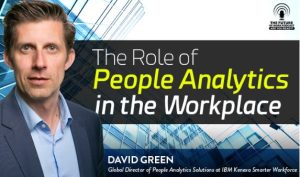David Green joined IBM about a year ago to help IBM customers grow their people analytics and technology. He has been involved with HR since the late 90’s and also writes and speaks about data driven HR.
Historically, HR decisions used ‘gut and intuition’ to drive decisions. Now the use of data in the form of people analytics is providing value, allowing better decisions to be made.
 One example is a large, global company that was looking at building in China. However, the head of the analytics looked at the data and discovered that it was not an ideal place to locate the company. It was found that the talent in the region was very ‘thin.’ The completion for this work group was high in the area, creating additional shortages. This would have made it difficult to not only hire the initially needed workers but then it would have also limited the planned expansion. This company did not open there — saving money and other possible difficulties.
One example is a large, global company that was looking at building in China. However, the head of the analytics looked at the data and discovered that it was not an ideal place to locate the company. It was found that the talent in the region was very ‘thin.’ The completion for this work group was high in the area, creating additional shortages. This would have made it difficult to not only hire the initially needed workers but then it would have also limited the planned expansion. This company did not open there — saving money and other possible difficulties.
Though there are examples such as this, there remain three areas of skepticism currently seen in the use of people analytics within the business community:
- The first is whether the business can adequately analyze the data.
- Secondly, they are often concerned about the cost of its use. Can they afford to invest in it?
- Finally, does the HR staff need to be ‘experts’ in data?
Start small
Green’s response to those areas of concern focus on the idea that people analytics is a long-term investment. It is not something that can be rolled out over night. His suggestion is to start small. If an organization has a hypothesis of what might be valuable information to gather –- start there. Don’t waste time and money on predicting for something that is not a problem for the organization, so give it some thought before you make time and money investments.
Three steps for a healthy start:
- Learn the business and what matters specifically to that one. Identify leaders within the organization who are open to the use of analytics.
- The Chief Human Resource Officer (CHRO) is involved and can assist with insights to focus upon.
- Ensure there is a ‘bold’ person at the head of analytics. Often a strong business and political background is needed to drive forward.
People analytics can often uncover counter intuitive issues. For example, it was commonly believed that graduates with high GPAs from Ivy League universities would be the most productive employees. However, Google’s use of analytics found – for them- that a higher GPA was not a good predictor of the best workers.
The caveat here though is that though this may be true for Google, it may not be true for other organizations. It is once again that ‘one size does not fit all’ and each organization must discover what works for them. One suggestion is to start with a small sampling – see if that works. Then validate the insight and work from there.
Analytics can be subjective
People analytics do have a subjective component to them. Insights can be skewed based on people’s interpretations or perceptions. This requires that the data is entered is accurately and there are checks and balances. Since this data is about people, it must be augmented with both judgment and transparency.
Transparency is a critical feature of people analytics – both legally and morally. Without it, people will revolt and the data will not provide the insights the company is looking for with its use. Nor will it be good for performance, retention or overall trust within the organization. If employee trust drives the implementation, then positive results will occur. This might include giving people the option to opt out of the program. Or it may include giving employees the data that is revealed. Microsoft has done this with positive results.
Advice for organizations looking at getting into people analytics includes:
- Just start!
- Be curious – ask how you know if you have the ‘right people’ how do we know if we are paying the right salaries?
- Read up on your particular business challenges – don’t copy (Google or …), talk to peers about your business
Listen to the podcast and make sure to subscribe on iTunes for more episodes.
This article first appeared on The Future Organization.
